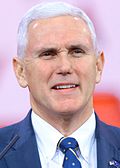 | |||||||||||
| |||||||||||
| |||||||||||
| |||||||||||
| | |
|---|---|
| Republican Party | |
| Democratic Party | |
| Third parties | |
| Related races | |
| |
| ||
|---|---|---|
Vice President of the United States
U.S. Representative for Indiana's 2nd and 6th districts Vice presidential campaigns | ||
Businessman Donald Trump of New York, the 2016 Republican nominee for President of the United States, considered several prominent Republicans and other individuals before selecting Governor Mike Pence of Indiana as his running mate on July 15, 2016. Pence formally won the vice presidential nomination at the 2016 Republican National Convention on July 19. The Trump–Pence ticket would go on to defeat the Clinton–Kaine ticket in the 2016 presidential election but ultimately lost to the Biden–Harris ticket in 2020.














































